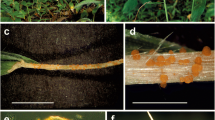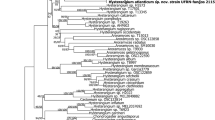Abstract
This study describes a novel ericoid mycorrhizal fungus (ErMF), Gamarada debralockiae Midgley and Tran-Dinh gen. nov. sp. nov. Additionally, catabolism was explored from a genomic perspective. The nuclear and mitochondrial genomes of G. debralockiae were sequenced. Morphological characteristics were assessed on various media. Catabolic genes of G. debralockiae were explored using SignalP and dbCAN. Phylogenetic comparisons were undertaken using Phylogeny.fr. The 58.5-Mbp draft genome of G. debralockiae contained 17,075 putative genes. The complete mitochondrial genome was 28,168 bp in length. In culture, G. debralockiae produces slow-growing non-sporulating colonies. Gamarada debralockiae has many putative secreted catabolic enzymes. Phylogeny indicated G. debralockiae was distinct from known ascomycetous ErMF: Pezoloma ericae, Meliniomyces spp., Oidiodendron spp., and Cairneyella variabilis. It is closely related to many undescribed plant root-associated fungi and its nearest described relative is Hyphodiscus brevicollaris. Gamarada debralockiae has been recovered from virtually all Australian ericoid mycorrhizal studies and biogeographic data suggests the taxon is widespread in Australia. Gamarada debralockiae has similar catabolic potential to C. variabilis and co-occurs with C. variabilis at Australian sites. Plants that host multiple ErMF may benefit from subtle differences in catabolism that improve access to nitrogen and phosphorus from within recalcitrant organic matter.



Similar content being viewed by others
References
Abuarghub SM, Read DJ (1988a) The biology of mycorrhiza in the Ericaceae. XI. The distribution of nitrogen in soil of a typical upland Callunetum with special reference to the ‘free’ amino acids. New Phytol 108:425–431
Abuarghub SM, Read DJ (1988b) The biology of mycorrhiza in the Ericaceae. XII. Quantitative analysis of individual ‘free’ amino acids in relation to time and depth in the soil profile. New Phytol 108:433–441
Anisimova M, Gascuel O (2006) Approximate likelihood-ratio test for branches: a fast, accurate, and powerful alternative. Syst Biol 55:539–552
Baral H-O, Krieglsteiner L (2006) Hymenoscyphus subcarneus, a little known bryicolous discomycete found in the Białowieża National Park. Acta Mycol 41:11–20
Bougoure DS (2006) Ericaceae root associated fungi revealed by culturing and culture-independent molecular methods. Doctor of Philosophy , University of Western Sydney
Bougoure DS, Cairney JWG (2005a) Assemblages of ericoid mycorrhizal and other root-associated fungi from Epacris pulchella (Ericaceae) as determined by culturing and direct DNA extraction from roots. Environ Microbiol 7:819–827
Bougoure DS, Cairney JWG (2005b) Fungi associated with hair roots of Rhododendron lochiae (Ericaceae) in an Australian tropical cloud forest revealed by culturing and culture-independent molecular methods. Environ Microbiol 7:1743–1754
Bougoure DS, Cairney JWG (2006) Chitinolytic activities of ericoid mycorrhizal and other root-associated fungi from Epacris pulchella (Ericaceae). Mycol Res 110:328–334
Bruzone MC, Fontenla SB, Vohník M (2015) Is the prominent ericoid mycorrhizal fungus Rhizoscyphus ericae absent in the Southern Hemisphere’s Ericaceae? A case study on the diversity of root mycobionts in Gaultheria spp. from northwest Patagonia, Argentina. Mycorrhiza 25:25–40
Bruzone MC, Fehrer J, Fontenla SB, Vohnik M (2016) First record of Rhizoscyphus ericae in southern Hemisphere’s Ericaceae. Mycorrhiza 27:147–163
Cairney JWG, Meharg AA (2003) Ericoid mycorrhiza: a partnership that exploits harsh edaphic conditions. Eur J Soil Sci 54:735–740
Castresana C (2000) The cluster: “responses to challenges of the environment”. In: Developments in Plant Genetics and Breeding pp 157–158
Chambers SM, Curlevski NJA, Cairney JWG (2008) Ericoid mycorrhizal fungi are common root inhabitants of non-Ericaceae plants in a south-eastern Australian sclerophyll forest. FEMS Microbiol Ecol 65:263–270
Chevenet F, Brun C, Bañuls A-L, Jacq B, Christen R (2006) TreeDyn: towards dynamic graphics and annotations for analyses of trees. BMC Bioinf 7:439
Curlevski NJA, Chambers SM, Anderson IC, Cairney JWG (2009) Identical genotypes of an ericoid mycorrhiza-forming fungus occur in roots of Epacris pulchella (Ericaceae) and Leptospermum polygalifolium (Myrtaceae) in an Australian sclerophyll forest. FEMS Microbiol Ecol 67:411–420
Dalpe Y (1986) Axenic synthesis of ericoid mycorrhiza in Vaccinium angustifolium Ait. by Oidiodendron species. New Phytol 103:391–396
Dereeper A, Guignon V, Blanc G, Audic S, Buffet S, Chevenet F, Dufayard JF, Guindon S, Lefort V, Lescot M, Claverie JM, Gascuel O (2008) Phylogeny.fr: robust phylogenetic analysis for the non-specialist. Nucleic Acids Res 36:W465–W469
Edgar RC (2004) MUSCLE: multiple sequence alignment with high accuracy and high throughput. Nucleic Acids Res 32:1792–1797
Greenfield P, Duesing K, Papanicolaou A, Bauer DC (2014) Blue: correcting sequencing errors using consensus and context. Bioinformatics 30:2723–2732
Guindon S, Dufayard J-F, Lefort V, Anisimova M, Hordijk W, Gascuel O (2010) New algorithms and methods to estimate maximum-likelihood phylogenies: assessing the performance of PhyML 3.0. Syst Biol 59:307–321
Hambleton S, Sigler L (2005) Meliniomyces, a new anamorph genus for root-associated fungi with phylogenetic affinities to Rhizoscyphus ericae (≡ Hymenoscyphus ericae), Leotiomycetes. Stud Mycol 53:1–27
Hoff KJ, Stanke M (2013) WebAUGUSTUS—a web service for training AUGUSTUS and predicting genes in eukaryotes. Nucleic Acids Res 41:W123–W128
Kohler A, Kuo A, Nagy LG et al (2015) Convergent losses of decay mechanisms and rapid turnover of symbiosis genes in mycorrhizal mutualists. Nat Genet 47:410–415
Kohout P, Tedersoo L (2017) Effect of soil moisture on root-associated fungal communities of Erica dominans in Drakensberg mountains in South Africa. Mycorrhiza 27:397–406
Kolarik M, Vohnik M (2018) When the ribosomal DNA does not tell the truth: the case of the taxonomic position of Kurtia argillacea, an ericoid mycorrhizal fungus residing among Hymenochaetales. Fungal Biology 122:1–18
Liu G, Chambers SM, Cairney JWG (1998) Molecular diversity of ericoid mycorrhizal endophytes isolated from Woollsia pungens. New Phytol 140:145–153
Martino E, Morin E, Grelet G-A, Kuo A, Kohler A, Daghino S, Barry KW, Cichocki N, Clum A, Dockter RB, Hainaut M, Kuo RC, LaButti K, Lindahl BD, Lindquist EA, Lipzen A, Khouja HR, Magnuson J, Murat C, Ohm RA, Singer SW, Spatafora JW, Wang M, Veneault-Fourrey C, Henrissat B, Grigoriev IV, Martin FM, Perotto S (2018) Comparative genomics and transcriptomics depict ericoid mycorrhizal fungi as versatile saprotrophs and plant mutualists. New Phytol 217:1213–1229
Marx DH, Bryan WC (1975) Growth and ectomycorrhizal development of loblolly pine seedlings in fumigated soil infested with the fungal symbiont Pisolithus tinctorius. For Sci 21:245–254
McLean CB, Cunnington JH, Lawrie AC (1999) Molecular diversity within and between ericoid endophytes from the Ericaceae and Epacridaceae. New Phytol 144:351–358
Midgley DJ, Chambers SM, Cairney JWG (2002) Spatial distribution of fungal endophyte genotypes in a Woollsia pungens (Ericaceae) root system. Aust J Bot 50:559
Midgley DJ, Chambers SM, Cairney JWG (2004a) Utilisation of carbon substrates by multiple genotypes of ericoid mycorrhizal fungal endophytes from eastern Australian Ericaceae. Mycorrhiza 14:245–251
Midgley DJ, Chambers SM, Cairney JWG (2004b) Distribution of ericoid mycorrhizal endophytes and root-associated fungi in neighbouring Ericaceae plants in the field. Plant Soil 259:137–151
Midgley DJ, Chambers SM, Cairney JWG (2004c) Inorganic and organic substrates as sources of nitrogen and phosphorus for multiple genotypes of two ericoid mycorrhizal fungal taxa from Woollsia pungens and Leucopogon parviflorus (Ericaceae). Aust J Bot 52:63
Midgley DJ, Jordan LA, Saleeba JA, McGee PA (2006) Utilisation of carbon substrates by orchid and ericoid mycorrhizal fungi from Australian dry sclerophyll forests. Mycorrhiza 16:175–182
Midgley DJ, Rosewarne CP, Greenfield P, Li D, Vockler CJ, Hitchcock CJ, Sawyer NA, Brett R, Edwards J, Pitt JI, Tran-Dinh N (2016) Genomic insights into the carbohydrate catabolism of Cairneyella variabilis gen. nov. sp. nov., the first reports from a genome of an ericoid mycorrhizal fungus from the southern hemisphere. Mycorrhiza 26:345–352
Midgley DJ, Greenfield P, Bissett A, Tran-Dinh N (2017) First evidence of Pezoloma ericae in Australia: using the biomes of Australia soil environments (BASE) to explore the Australian phylogeography of known ericoid mycorrhizal and root-associated fungi. Mycorrhiza 27:587–594
Petersen TN, Brunak S, von Heijne G, Nielsen H (2011) SignalP 4.0: discriminating signal peptides from transmembrane regions. Nat Methods 8:785–786
Pitt JI, Hocking AD (2009) Fungi and food spoilage. Springer, Boston, MA
Smith SE, Read DJ (2010) Mycorrhizal symbiosis. Academic Press, Cambridge
Van Leerdam DM, Williams PA, CJW G (2001) Phosphate-solubilising abilities of ericoid mycorrhizal endophytes of Woollsia pungens (Epacridaceae). Aust J Bot 49:75–80
Villarreal-Ruiz L, Anderson IC, Alexander IJ (2004) Interaction between an isolate from the Hymenoscyphus ericae aggregate and roots of Pinus and Vaccinium. New Phytol 164:183–192
Vohník M, Mrnka L, Lukesova T, Bruzone MC, Kohout P, Fehrer J (2013) The cultivable endophytic community of Norway spruce ectomycorrhizas from microhabitats lacking ericaceous hosts is dominated by ericoid mycorrhizal Meliniomyces variabilis. Fungal Ecol 6:281–292
Vohník M, Pánek M, Fehrer J, Selosse M-A (2016) Experimental evidence of ericoid mycorrhizal potential within Serendipitaceae (Sebacinales). Mycorrhiza 26:831–846
Whittaker SP, Cairney JWG (2001) Influence of amino acids on biomass production by ericoid mycorrhizal endophytes from Woollsia pungens (Epacridaceae). Mycol Res 105:105–111
Williams AF, Chambers SM, Davies PW et al (2004) Molecular investigation of sterile root-associated fungi from epacris Microphylla R.Br.(Ericaceae) and other Epacrids at Alphine, sub-alpine and coastal heathland sites. Aust Mycol 23:94–104
Yin Y, Mao X, Yang J, Chen X, Mao F, Xu Y (2012) dbCAN: a web resource for automated carbohydrate-active enzyme annotation. Nucleic Acids Res 40:W445–W451
Zerbino DR, Birney E (2008) Velvet: algorithms for de novo short read assembly using de Bruijn graphs. Genome Res 18:821–829
Acknowledgments
We thank Mr. Mark Wilson for accessioning cultures into the FRR culture collection.
Author information
Authors and Affiliations
Corresponding author
Rights and permissions
About this article
Cite this article
Midgley, D.J., Sutcliffe, B., Greenfield, P. et al. Gamarada debralockiae gen. nov. sp. nov.—the genome of the most widespread Australian ericoid mycorrhizal fungus. Mycorrhiza 28, 379–389 (2018). https://doi.org/10.1007/s00572-018-0835-y
Received:
Accepted:
Published:
Issue Date:
DOI: https://doi.org/10.1007/s00572-018-0835-y




